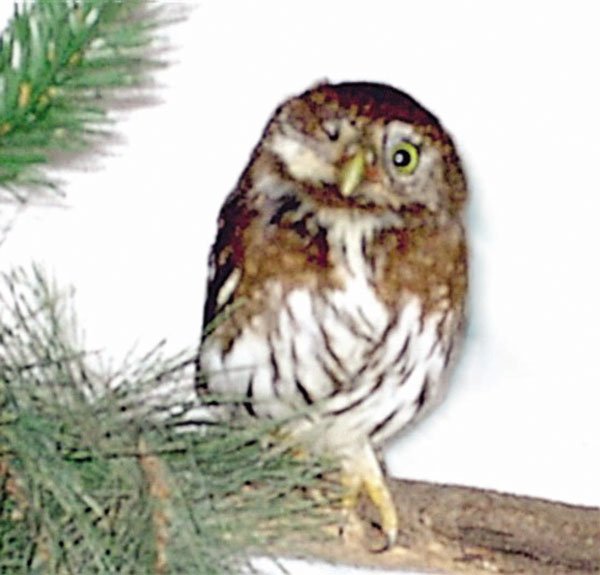Predators. In North America, usually what comes to mind is some
large animal stalking prey far away in the hinterlands
– mountain lions and jaguars and grizzly bears, oh my!
By the Wildlife Education and Rehabilitation Center
Predators. In North America, usually what comes to mind is some large animal stalking prey far away in the hinterlands – mountain lions and jaguars and grizzly bears, oh my! But right here in the South Bay, we have one of the most ferocious hunters of all: the 6-inch long Northern Pygmy Owl.
The tiny, feathered fighter hunts in the daytime, sitting quietly on a high tree branch until some unlucky bird, rodent or reptile appears in its view. The Pygmy Owl has a tremendous range of prey, killing birds and mammals twice its size, including quail, robins, chipmunks and weasels, as well as toads, snakes and large insects.
Because of its diet and ferocity, the owl is often mobbed by songbirds that are protecting their nests. This behavior may account for the Pygmy Owl’s distinctive feature: On the back of its head are two black-and-white spots that mimic the owl’s eyes and beak. To a bird flying overhead, it would appear that the owl is looking right up at it, ready to attack.
The Northern Pygmy Owl is non-migratory, but it ranges throughout most of the western United States and much of British Columbia. It lives in open coniferous forests by the edge of meadows, fields and lakes, where the clearings provide easy access to food and the nearby trees provide shelter and nesting sites in abandoned woodpecker holes. Apparently, Hecker Pass in Gilroy is a prime habitat for this species, as WERC discovered with surprise in January.
This little owl was out hunting one afternoon, maybe intent in pursuit of a jay, when he flew across the road right into a passing vehicle. Fortunately, the driver of a following car witnessed the accident and was able to rescue the injured bird.
An examination at WERC showed grievous damage to the right eye, which was swollen, non-responsive and discolored. For one week, WERC treated the owl and carefully monitored his progress. He had no other injuries and had a very healthy appetite, but the eye was not healing properly. Sadly, veterinarians confirmed that the eye was permanently blind. Sight is far too important for an owl’s survival in the wilds – it could never be released.
But this is not the end of the story. The owl was brought to Dr. Kristina Burling and Dr. Patrick McCallum, veterinarians at Animal Eye Specialists in San Jose, who performed surgery to remove the painfully injured eye.
After two weeks of intensive care, this one-eyed owl is on the road to a complete recovery. Wildlife caregivers determined that he has the disposition that makes him an excellent candidate for educational programs. WERC is now searching for a suitable licensed wildlife facility for him so that he can live happily ever after to inspire and educate children and adults, just as does Napoleon, WERC’s own non-releasable, educational Northern Pygmy Owl.
WERC, the Wildlife Education and Rehabilitation Center, provides the community with rehabilitation services for orphaned, injured and sick native wildlife. Through their educational programs, WERC encourages a peaceful coexistence between civilization and native wildlife.
To contact WERC, call (408) 779-9372 or visit www.werc-ca.org.














